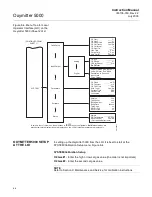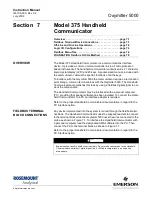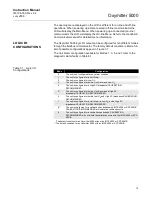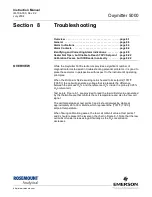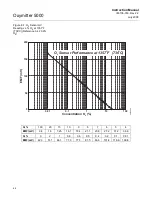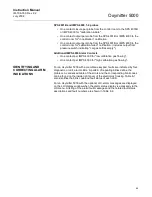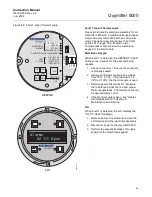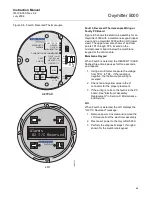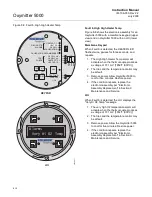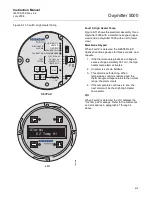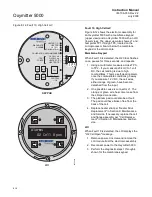
Instruction Manual
IM-106-350, Rev 2.2
July 2008
8-3
Oxymitter 5000
GENERAL
The troubleshooting section describes how to identify and isolate faults that
may develop in the Oxymitter 5000. When troubleshooting, reference the
following.
Grounding
It is essential that adequate grounding precautions are taken when installing
the system. Thoroughly check both the probe and electronics to ensure the
grounding quality has not degraded during fault finding. The system provides
facilities for 100% effective grounding and the total elimination of ground
loops.
Electrical Noise
The Oxymitter 5000 has been designed to operate in the type of environment
normally found in a boiler room or control room. Noise suppression circuits
are employed on all field terminations and main inputs. When fault finding,
evaluate the electrical noise being generated in the immediate circuitry of a
faulty system. Ensure all cable shields are connected to earth.
Loose Integrated Circuits
The Oxymitter 5000 uses a microprocessor and supporting integrated circuits
(IC). If the electronics are handled roughly during installation or located where
subjected to severe vibration, the ICs could work loose. Before troubleshoot-
ing the system, ensure all ICs are fully seated.
Electrostatic Discharge
Electrostatic discharge can damage the ICs used in the electronics. Before
removing or handling the processor board or the ICs, ensure you are at
ground potential.
ALARM INDICATIONS
Once an alarm condition is identified, the Oxymitter 5000 electronics offers a
number of diagnostics to interpret the specific alarm.
If the Oxymitter 5000 has the simple keypad operator interface, the majority of
fault conditions will be indicated by one of the four LEDs referred to as
diagnostic, or unit alarms on the operator's keypad (Figure 8-2). An LED will
flash a code that will correspond to an error message. Only one LED will blink
at a time. An alarm code guide is provided inside the screw-on cover for the
electronics.
Alarm indications will also be available via fieldbus computer terminal or the
optional LOI. When the error is corrected and/or power is cycled, the diagnos-
tic alarms will clear or the next error on the priority list will appear.
Install all protective equipment covers and safety ground leads after troubleshooting. Failure
to install covers and ground leads could result in serious injury or death.
Summary of Contents for Oxymitter 5000
Page 2: ......
Page 6: ......
Page 12: ......
Page 22: ...Oxymitter 5000 xii Instruction Manual IM 106 350 Rev 2 2 July 2008 ...
Page 42: ...Oxymitter 5000 1 20 Instruction Manual IM 106 350 Rev 2 2 July 2008 ...
Page 62: ...Oxymitter 5000 2 20 Instruction Manual IM 106 350 Rev 2 2 July 2008 ...
Page 74: ...Oxymitter 5000 4 6 Instruction Manual IM 106 350 Rev 2 2 July 2008 ...
Page 78: ...Oxymitter 5000 5 4 Instruction Manual IM 106 350 Rev 2 2 July 2008 ...
Page 94: ...Oxymitter 5000 7 6 Instruction Manual IM 106 350 Rev 2 2 July 2008 ...
Page 140: ...Oxymitter 5000 9 22 Instruction Manual IM 106 350 Rev 2 2 July 2008 ...
Page 184: ...Oxymitter 5000 B 2 Instruction Manual IM 106 350 Rev 2 2 July 2008 ...
Page 204: ...Oxymitter 5000 D 14 Instruction Manual IM 106 350 Rev 2 2 July 2008 ...
Page 222: ...Oxymitter 5000 E 18 Instruction Manual IM 106 350 Rev 2 2 July 2008 ...
Page 224: ...Instruction Manual IM 106 350 Rev 2 2 July 2008 Index 2 Oxymitter 5000 ...


